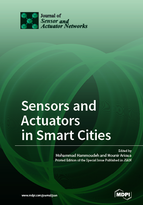Sensors and Actuators in Smart Cities
A special issue of Journal of Sensor and Actuator Networks (ISSN 2224-2708). This special issue belongs to the section "Actuators, Sensors and Devices".
Deadline for manuscript submissions: closed (31 October 2017) | Viewed by 88769
Special Issue Editors
Interests: wireless sensor networks; Internet of things; wireless ad hoc communications; mobile communications; network security; sensor/actuator networks; cyber–physical systems
Special Issues, Collections and Topics in MDPI journals
Interests: wireless sensor networks; wireless networking and communication; wireless communications and mobile computing; Internet of things; real-time processing and embedded systems
Special Issue Information
Dear Colleagues,
With the city, from its earliest emergence in the Near East between 4500 and 3100 BCE, came a wide range of new discoveries and inventions, from synthetic materials to wheeled vehicles. Through its dense population, irrigation, social continuity and physical security, emerged civil engineering, monumental construction, sculpture, mathematics, arts and law. Today, there is an enormous set of ideas and notions with respect to our ways of living, e.g., the ramp and the lever, which are still fundamental to cities’ environmental, social, and economic structures. Modern-day smart cities compete for the introduction of smart technologies and applications to improve key areas of urban communities, such as system automation, sustainability, and quality of life. Technology research experts paint thrilling images of futuristic cities. What’s glossed over, however, is the sensor and actuator technologies that enable these smart cities; in particular, the reliable, heterogeneous, wireless networks specifically designed to provision communication across a countless number of sensors embedded in almost everything.
The world is on the verge of a new epoch of innovation and change with the emergence of Wireless Sensor Networks (WSN). The convergence of smaller, more powerful processors, smart mobile devices, low-cost sensing, big data analytics, cloud hosting and new levels of connectivity allowed by the Internet is fuelling the latest wave of Machine-to-Machine (M2M) technology. The merits of this marriage of machines and the digital world are multiple and significant. It holds the potential to dramatically alter the way in which most global industries, such as buildings, rail transportation, power grids and healthcare operate on daily basis. WSNs expand to include our vehicles and homes, as well as newly developed wearable and implanted sensors, which brings fundamental transformations to many aspects of daily life.
WSN innovations promise to integrate and optimise smart buildings, autonomous vehicles, power grids, etc., to enable a successful transition towards smart, user-driven and demand-focused city infrastructures and services. There is a wide range of current smart cities applications, which make our lives easier and more efficient, e.g., a smart phone application that let users find free parking spaces in the centre of town. However, cities are notoriously inefficient. As populations grow, everything from garbage collection and public transport becomes more expensive and complex. Away from increasing spending, there is also a demand among citizens for smarter services driven by sensor- and actuator-based infrastructure.
In this Special Issue, we are seeking submissions that focus on implementing intelligent sensing infrastructure to solve the smart cities conundrum. This Special Issue invites academic researchers in computer science, communication engineering and physics, as well as information technology industry consultants and practitioners, to contribute original contributions in all aspects of sensors and actuators for smart cities. Authors of selected outstanding papers in the International Conference of Future Networks and Distributed Systems will be invited to submit extended versions of their papers for consideration in this Special Issue.
Contributions may include, but are not limited to:
- Smart city architecture and infrastructure
- WSN and Internet of Things (IoT) architectures, protocols, platforms and algorithms
- Smart city technologies and applications
- Enabling wireless and mobile technologies for smart cities
- Intelligent sensors and actuators for homes, buildings and infrastructures
- Embedded sensing and actuating
- WSN for enabling technologies for precision healthcare
- Intelligent transportation systems and technologies
- Smart sewage and water
- Smart electricity, grids and meters
- Smart city community connectivity and solutions
- City environment monitoring and analysis
- Smart city sensing and IoT
- Smart city big data and open data
- Smart city system security and privacy
- Inclusive design of smart cities and smart environments
- Application, deployment, testbed, experiment experiences and innovative applications for smart cities
- Successful case studies in development or deployment of WSN applications and services in the area of accessibility
Dr. Mohammad Hammoudeh
Dr. Mounir Arioua
Guest Editors
Manuscript Submission Information
Manuscripts should be submitted online at www.mdpi.com by registering and logging in to this website. Once you are registered, click here to go to the submission form. Manuscripts can be submitted until the deadline. All submissions that pass pre-check are peer-reviewed. Accepted papers will be published continuously in the journal (as soon as accepted) and will be listed together on the special issue website. Research articles, review articles as well as short communications are invited. For planned papers, a title and short abstract (about 100 words) can be sent to the Editorial Office for announcement on this website.
Submitted manuscripts should not have been published previously, nor be under consideration for publication elsewhere (except conference proceedings papers). All manuscripts are thoroughly refereed through a single-blind peer-review process. A guide for authors and other relevant information for submission of manuscripts is available on the Instructions for Authors page. Journal of Sensor and Actuator Networks is an international peer-reviewed open access semimonthly journal published by MDPI.
Please visit the Instructions for Authors page before submitting a manuscript. The Article Processing Charge (APC) for publication in this open access journal is 2000 CHF (Swiss Francs). Submitted papers should be well formatted and use good English. Authors may use MDPI's English editing service prior to publication or during author revisions.







